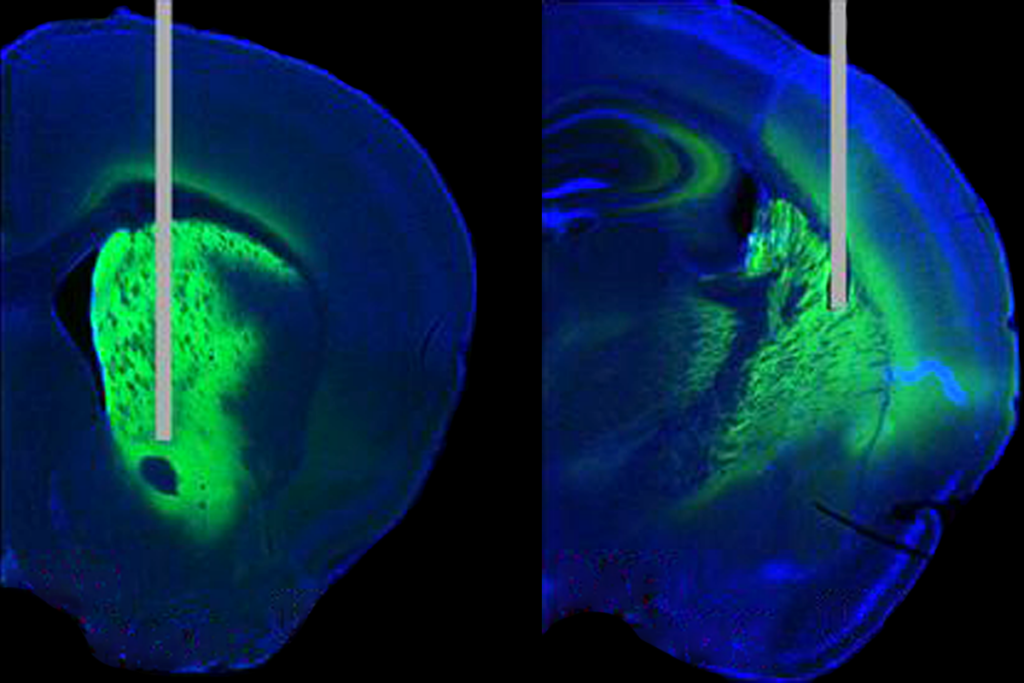Miniature microscope records thousands of neurons in moving mice
The open-source device achieves subcellular resolution in a larger tissue volume than was possible with prior miniscopes, without impinging upon a mouse’s behavior.
A new miniature, head-mounted microscope can simultaneously record the activity of thousands of neurons at different depths within the brains of freely moving mice. The smallest functional two-photon microscope to date, it can image neurons almost anywhere in the brain, with subcellular resolution. The device, called MINI2P (miniature two-photon microscope), can also collect data from the same cluster of neurons over several weeks, making it useful for long-term behavioral studies.
“If you really want to understand what is behind cognition or failures in cognition, like in autism, you need to look at the interaction between neurons,” says lead investigator Edvard Moser, professor of neuroscience at the Kavli Institute for Systems Neuroscience in Trondheim, Norway.
Other devices that measure neuronal activity, such as Neuropixels 2.0, record signals from more than 10,000 sites in the brain at once. But they have a low spatial resolution and cannot always determine which specific neuron is firing at any given time. Other miniature microscopes have also, traditionally, relied on visible light, which illuminates the surface of tissue, but are limited to imaging about 2,000 neurons.
The new device can monitor a brain area measuring 500 by 500 micrometers and can capture data on more than 10,000 neurons at once. A typical mouse brain is roughly the size of a pea and contains about 85 million neurons.
T
he MINI2P uses infrared light to capture the activity of neurons engineered to express GCaMP, a protein that binds to calcium ions during an action potential and emits a fluorescent signal in reply. The microscope measures that fluorescence using an infrared laser beam.An electrically controlled lens system quickly switches the new microscope’s focus between different depths in the brain, even as mice climb and jump about in their cage. The MINI2P is open source and was reported in Cell in March.
“This MINI2P system could be a game changer for our field,” says Denise Cai, associate professor of neuroscience at the Icahn School of Medicine at Mount Sinai in New York, who was not involved in the study and has developed miniature, one-photon microscopes.
Recording large groups of neurons in moving mice, at single-cell resolution and over long time periods, says Cai, “will vastly expand the types of questions we can ask and the conclusions we can make about the neural circuits that underlie behavior.”
The MINI2P has been percolating in the Moser lab for more than 20 years, according to study investigator Weijian Zong, a researcher in Moser’s group.
An earlier version of the device, reported in Nature Methods last year, weighed 4.2 grams — enough to slow a mouse down and disrupt its natural movement. Mice with a 5-gram block strapped to their head move more than a third as slowly and travel roughly a third of the distance as do mice with a 3-gram block — or no block — on their head, according to the new study.
The new version weighs 2.4 grams, about the same as a penny. Shrinking it to this size required three engineering advances: A lighter case, built from a plastic-like material instead of aluminum; a thinner, more flexible optical cable so that mice could run about their cage without getting tangled by wires; and a micro-tunable lens that, when jolted by electricity, quickly changes its curvature and focal point. Each lens weighs 15 milligrams, comparable to those used in smartphone cameras.
With the new lens, Zong says, researchers can image multiple slices of the brain faster than GCaMP’s calcium signal occurs. In other words, in a single experiment, they can record neuronal activity from multiple depths of the brain as a mouse moves about its cage and then later merge those recordings to construct a 3D video. Applying a motion-correction algorithm during video processing reduces data noise, even if a mouse climbs and jumps off of walls.
In one experiment, MINI2P targeted excitatory neurons in layer 2/3 of the visual cortex. As mice roamed around their cage, the researchers flipped between 25 different sites in the brain, at two different depths, to collect videos from more than 10,000 neurons at once. In another experiment, they recorded the same batch of visual cortex neurons four times over the space of five weeks; even as the device was detached and reattached between recordings, they were able to match up 36 percent of cells.
T
he MINI2P costs between $110,000 and $140,000 with the lasers and about $3,000 on its own.Another microscopy technique, structured illumination, may offer a more affordable way to collect similar data, says Emily Gibson, associate professor of bioengineering at the University of Colorado Anschutz Medical Campus in Denver. Using a $500 LED — no lasers required — Gibson’s group built a miniature microscope that images neurons up to 120 micrometers deep in the brain in three dimensions. Still, Gibson says, the MINI2P “is quite remarkable” and involved “a lot of engineering and design.”
The MINI2P is advantageous for certain experiments because it can image the same cluster of neurons over several weeks with subcellular resolution, says Tobias Rose, group leader at the University of Bonn Medical Center in Germany, who was not involved in the work.
That means researchers can image axonal projections over time, for instance, or as mice learn a behavior, to understand plasticity in the brain, Rose says. “And this is something you can’t do with widefield microscopes.”
Recommended reading

What are the most transformative neuroscience tools and technologies developed in the past five years?

New dopamine sensor powers three-color imaging in live animals

Bespoke photometry system captures variety of dopamine signals in mice
Explore more from The Transmitter

The Transmitter’s most-read neuroscience book excerpts of 2025

Neuroscience’s leaders, legacies and rising stars of 2025
